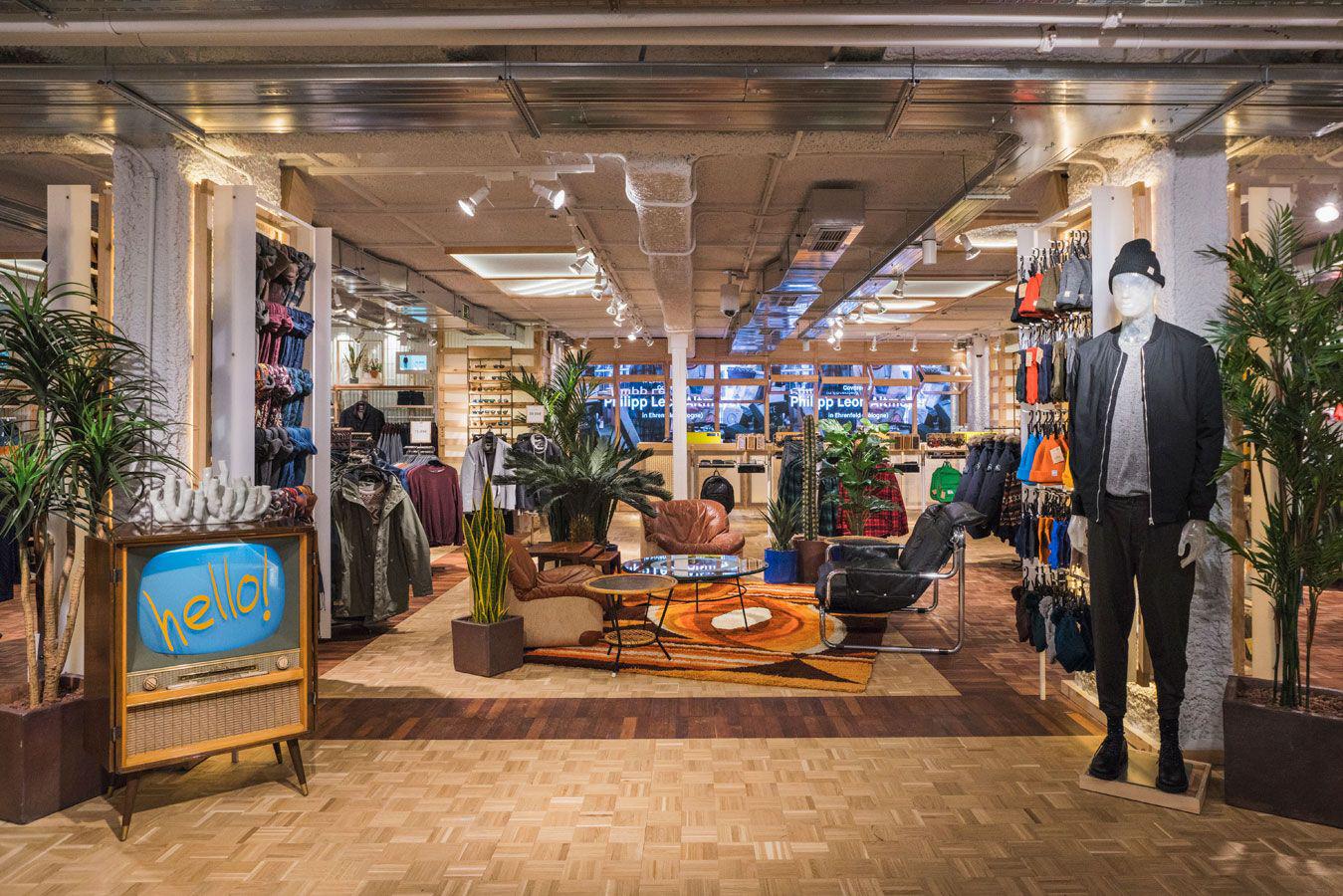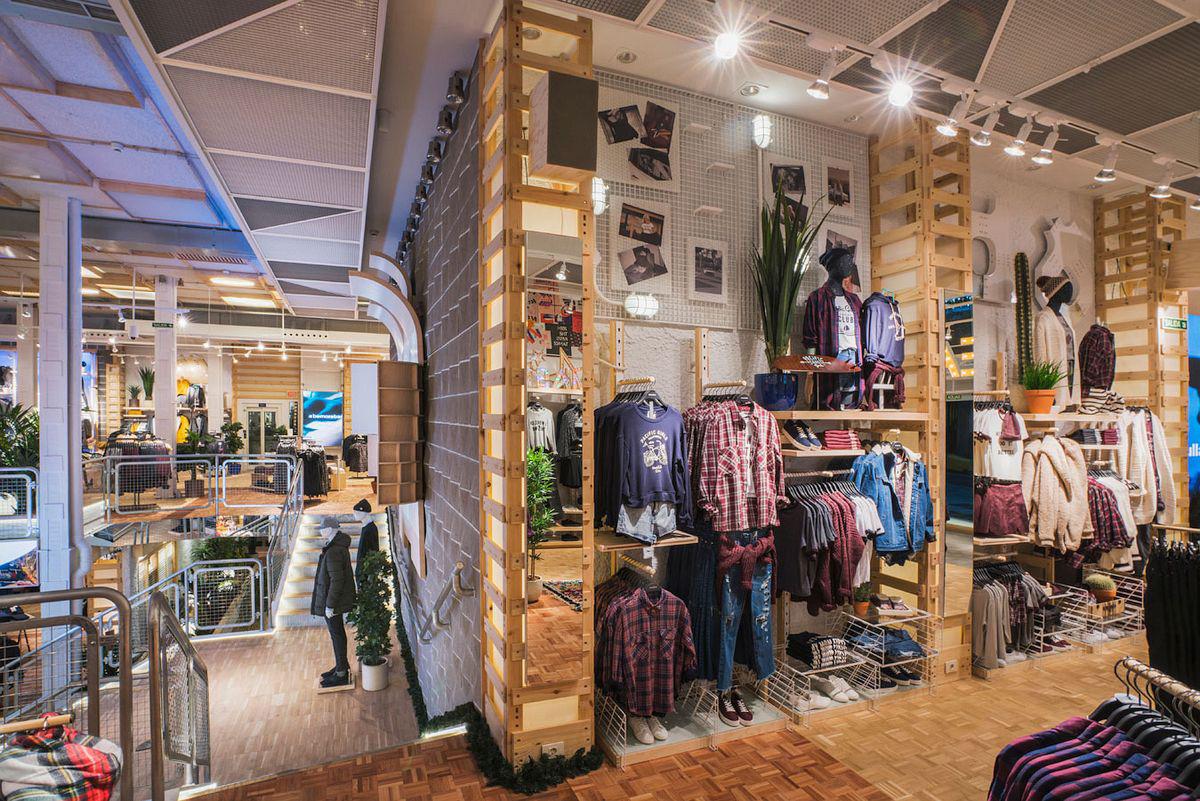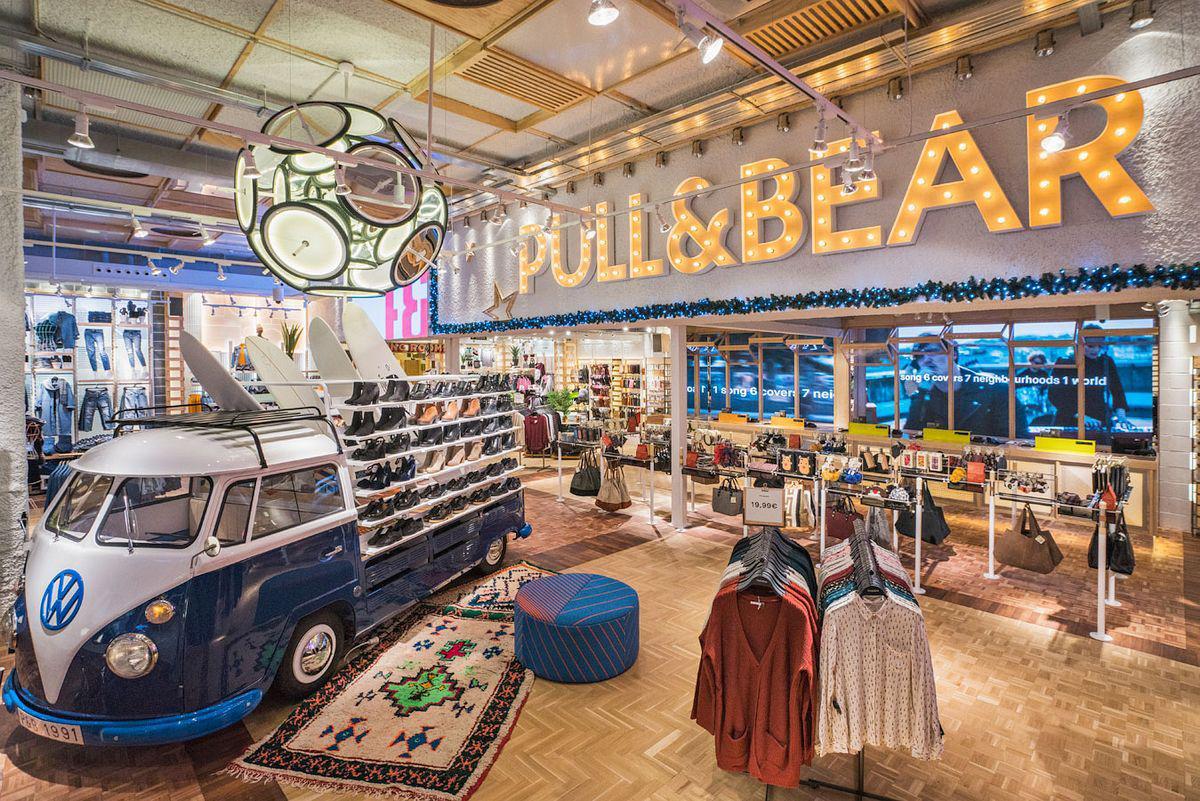
Pull & Bear, the youth fashion brand is shifting its demographic catchment from teens to generation Y, through marketing its Heritage range. It is one of the eight brands of the umbrella company Inditex. The Pull & Bear company operates 970 stores globally.
The shopfront and window display, a characteristic element of a fashion retailer's traditional storefront, is shop windows containing mannequin displays and promotions. All this has been jettisoned by the company in lieu of using architectural obscured glass block walls for windows to the left and right of the store entrance. This technique heightens and attracts the attention of a passer-by, thanks to visual colour projections to the back of architectural obscured glass block walls. The intention is to arouse the interest of a passer-by and invite them to step inside to discover the new retail space and fashion garments.”
The Pull&Bear store theme focuses on a West Coast California lifestyle scene, which also draws inspiration from Palm Springs and other parts of America.

Inside the store, the interior has been designed to include an eclectic mix of reclaimed finishes and merchandising systems. A 1970s television welcomes customers as they enter the store, which is supported by 1950s and 60s leather chairs, coffee tables and a stylish 70s rug. Recovered DIY building materials, such as painted concrete, pinewood, restored doors and textured walls. The sprayed low-density cementitious compound is applied on columns and ceiling, producing a raw and rustic look to the interior design. Please see the image above.
The store concept is a nostalgic vintage decor catapulting the interior into the past decades of the 20th century. The mix of the 80s and 90s accents of this interior treats the past century as a catalogue of retro gadgets and brick-a-brack as a source inspiration for the store design.
The store layout, furniture, lighting, music, digital screens and all other materials have been carefully curated to offer the customer a dynamic, eclectic and unique brand experience. The interior design follows the collections and flexibility in merchandising the fashion ranges is key to the brands' success.

In the centre of the store your attention is drawn to VW camper van that has been converted into a shoe display with surfboards and a seat for trying the product on is located at the rear of the van. The license plate reads “P&B 1991“ the year Pull&Bear was founded.

The bus and surfboards designate the fashion segment: casual men's and women's wear is showcased in this area.
 The walls are visually merchandised with products being divided into different sections. The concept is actually quite simple: the walls are decorated with repurposed clay pots and other types of clay embellishments. The clothes in these sections are colour-coordinated. The mannequin torsos and legs above the merchandise showcase selected pieces of the collection. This makes it easier to find your way around the store.
The walls are visually merchandised with products being divided into different sections. The concept is actually quite simple: the walls are decorated with repurposed clay pots and other types of clay embellishments. The clothes in these sections are colour-coordinated. The mannequin torsos and legs above the merchandise showcase selected pieces of the collection. This makes it easier to find your way around the store.

The visual merchandising (VM) instore at Pull&Bear consists of the visual the presentation of a store and its merchandise in ways that attract the attention of potential customers. Pull & Bears' VM activity seeks to design, develop and locate their internal three-dimensional displays on floor plans to create an optimal brand image for the store and sales success.
In order to maximise the sales performance of the store, the VM systems aim to attract engage and motivate the customers towards making a purchase both primary, secondary and tertiary product purchases from the range of goods and services.

The primary purpose of a fixture is to effectively display merchandise. The design of the fixture system is to work in concert with other design elements such as floor and wall mounted merchandising systems, combined with floor and wall coverings and lighting to reflect the overall brand image of the store.

Lighting is another key feature, both inside, where it focuses on the garments, and outside, where the backlit architectural glass block windows and big LED screens all to add to cast special energy for the store brand. Sustainability is paramount.
All timber used comes from certified forest productions guaranteeing traceable timber. The store also takes a big leap ahead in terms of integrating e-commerce with the physical point of sale. The range of online services is more visible in the store, with messages drawing a more aligned activity between the online store and offline the brick-and-mortar to create a unique shopping experience.
Pull & Bear have also made a significant effort in terms of eco-efficiency. Besides opting for LEED certification, which acknowledges environmental commitment in the design of the points of sales, all the stores are designed with value cost savings placed on aspects of energy-saving, efficient use of water, reductions in CO2 emissions, improvement in interior environmental quality, proper administration of resources and awareness-raising about environmental impact.

Finally the trends:-
1. Experiential retail engagement: The old model of in-store and even online retail focused on products being sold. However, consumers have slowly been moving away from shopping for products. Instead, they now seek more engaging experiences. The trend has been driven largely by Generation Y and Z who prefer experiences over products. As a consequence, customer engagement remains a high priority for retailers.
2. Social shopping: Social media will become the new storefront. First some statistics.
60% of people discover products on Instagram and 78% of Americans use Facebook to find new products.
30% of consumers would buy through social media platforms like Facebook, Instagram, Twitter, or Snapchat.
74% of shoppers are ready to make a purchase through a chatbot on social media.
More and more customers turn to social media for product discovery and they are ready to buy in-app.
With Instagram, you can tag your images and stories with the products that are featured in your posts. Then your audience can tap to go straight to your store to make the purchase.
3. Couture revival: Thanks to fast fashion, consumers can get the latest designer looks for a small fraction of the price.
4. E-commerce continues its retailer-led communities: Retailers are quickly catching on to the fact that effective brand communities help build closer relationships between consumers and brands and create long term loyalty.
5, Multi-channel is the new norm: Interestingly, the current brick-and-mortar retail model has seen the closure rate of stores in the USA and Europe. We believe the store will transition from the primary point of sales to being part of a broader omnichannel retail sales strategy.
Our internal process of renewal, allows us to continually benchmark and write about the best in class branding and design in many market sectors across the globe. The images in this article have been taken from the web and are attributed to other brand consultants.
Please take a moment to review other news items linked to this page.
Why not call and talk to us about your brand, design or change programme, digital and social media requirements.

